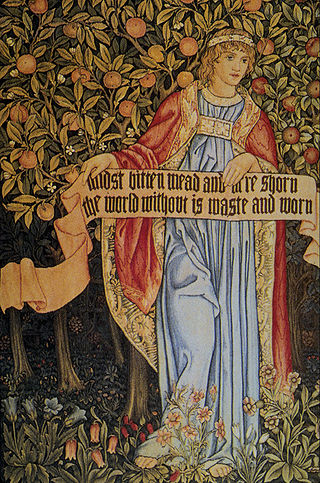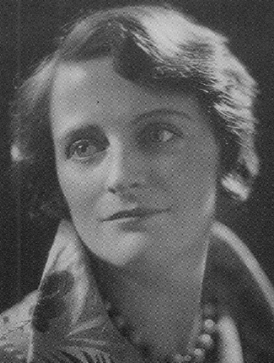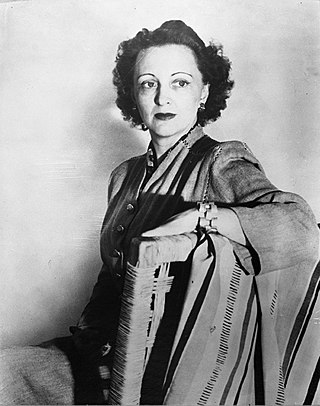
Morris, Marshall, Faulkner & Co. (1861–1875) was a furnishings and decorative arts manufacturer and retailer founded by the artist and designer William Morris with friends from the Pre-Raphaelites. With its successor Morris & Co. (1875–1940) the firm's medieval-inspired aesthetic and respect for hand-craftsmanship and traditional textile arts had a profound influence on the decoration of churches and houses into the early 20th century.

Textile design, also known as textile geometry, is the creative and technical process by which thread or yarn fibers are interlaced to form a piece of cloth or fabric, which is subsequently printed upon or otherwise adorned. Textile design is further broken down into three major disciplines: printed textile design, woven textile design, and mixed media textile design. Each uses different methods to produce a fabric for variable uses and markets. Textile design as an industry is involved in other disciplines such as fashion, interior design, and fine arts.

John Henry Dearle was a British textile and stained-glass designer trained by the artist and craftsman William Morris who was much influenced by the Pre-Raphaelite Brotherhood. Dearle designed many of the later wallpapers and textiles released by Morris & Co., and contributed background and foliage patterns to tapestry designs featuring figures by Edward Burne-Jones and others. Beginning in his teens as a shop assistant and then design apprentice, Dearle rose to become Morris & Co.'s chief designer by 1890, creating designs for tapestries, embroidery, wallpapers, woven and printed textiles, stained glass, and carpets. Following Morris's death in 1896, Dearle was appointed Art Director of the firm, and became its principal stained glass designer on the death of Burne-Jones in 1898.
Franco Scalamandré was an Italian-born American co-founder of Scalamandré Inc., a US manufacturer of traditional textiles, decorative textile trims, wall covering, and carpeting.
Designers Guild is an international home and lifestyle company with a flagship store and showrooms on Kings Road and Marylebone High Street in London, as well as offices in London, Paris, and Munich.
Kravet Inc., is a home furnishings company established in 1918. This fifth generation family business distributes fabrics, furniture, wallcoverings, trimmings, carpets and accessories.
Vera Neumann was an American artist and entrepreneur best known for her boldly colored linen patterns and scarves signed "Vera" and featuring a ladybug.
Donghia is an American brand of decoration for furniture, textiles, lighting, and accessories. Italian-American interior designer Angelo Donghia founded Donghia in 1968. It is currently owned by Kravet Inc.

Angelo Donghia was an American interior designer.
The Nazmiyal Collection, based in New York City, is a company that buys, sells, repairs and restores antique and decorative carpets and textiles.
Moroccan rugs are the weaves, carpets, and textiles that have been traditionally hand-woven in Morocco. Rugs have been woven by the indigenous people of Morocco since the Paleolithic Era. Twentieth-century Moroccan rugs are widely collected in the West, and are almost always woven by tribes people who do not seek nor possess formal artistic training.

Angela Adams is an American rug designer. Adams partnered with her husband and furniture designer, Sherwood Hamill, to launch a website, dedicated to the creation of custom rugs and custom furniture in Portland, Maine.

Marion Victoria Dorn also known as Marion Dorn Kauffer was a textile designer primarily in the form of wall hangings, carpeting and rugs, however she is also known to have produced wallpaper, graphics, and illustrations. Known for her significant contributions to modern British interiors in particular for her 'sculpted' carpets, she contributed to some of the best-known interiors of the time including the Savoy Hotel, Claridges, the Orion and the Queen Mary. In the late 1930s and early 1940s she created moquette fabric designs for use in London Transport passenger vehicles.
Roger Oates Design is a British company that designs, manufactures and retails flooring, fabric and interior products. The company is best known for Venetian Flatweave, a narrow width wool floorcovering usually fitted as a stair runner.

Marianne Strengell was an influential Finnish-American Modernist textile designer in the twentieth century. Strengell was a professor at Cranbrook Academy of Art from 1937 to 1942, and she served as department head from 1942 to 1962. She was able to translate hand-woven patterns for mechanized production, and pioneered the use of synthetic fibers.

Ilonka Karasz, was a Hungarian-American designer, interior decorator, painter and illustrator known for avant-garde industrial design and for her many New Yorker magazine covers.

Josefine Pola Stout was an American designer best known for creating fine woolen fabrics. Born in Stryi, she studied with Josef Hoffmann at the Kunstgewerbe Schule in Vienna, and designed for the Wiener Werkstätte before she immigrated to the United States in 1925 with her first husband, architect and designer Wolfgang Hoffmann. Wolfgang and Pola Hoffmann became a prominent interior design team that contributed to the development of American modernism in the early 20th century. They dissolved their successful partnership in 1932, when she married popular mystery author Rex Stout. Pola Stout was an influential textile designer after her second marriage. She was executor of Rex Stout's literary estate after her husband's death in 1975.

Betty Joel was a British furniture, textile and interior designer, active in England from c. 1921 until 1937. Her work was featured in The Studio, the illustrated fine arts and decorative arts magazine, from 1927 to 1937. Examples of her work can be seen in the Victoria & Albert Museum, London and the Geffrye Museum, London.

Eva-Lisa "Pipsan" Saarinen Swanson (March 31, 1905 – October 23, 1979) was a Finnish-American industrial, interior, and textile designer based in Michigan. She was known for her contemporary furniture, textile, and product designs.

Kyle Bunting is a textile designer specializing in handcrafted hair-on-hide rugs. The original creator of the decorative hide rug, Bunting has collaborated with numerous designers and designed for celebrities.












